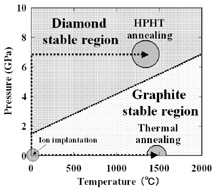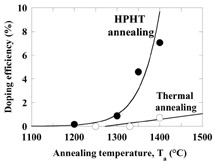Materials Science Laboratory
Ion implantation is a widely used doping technique for semiconductors
such as Si and GaAs. However, ion implantation severely damages the crystal.
In Si and GaAs, the damage can be easily recovered by thermal annealing
in a vacuum or in an inert gas. However, it is extremely difficult to recover
the damage in diamond by thermal annealing. One possible reason is that
the annealing condition is not located in diamond's stable region but rather
in graphite's stable region. Therefore, we propose high-pressure and high-temperature
(HPHT) annealing as a new activation method for ion-implanted dopants in
diamond. The concept is to recover from implantation-induced damage by
annealing under high pressure, that is, under diamond's stable condition
(Fig. 1) [1, 2]. Here, we show that HPHT annealing is highly effective
for damage recovery in ion-implanted diamond.
Homoepitaxial diamond films were grown on Ib-type diamond (100) single
crystals by microwave plasma CVD. Boron (B) ions were implanted at an acceleration
voltage of 60 keV with a dose of 1×1015 cm-2. The HPHT annealing of the B-implanted films was performed using a cubic-anvil-type
high-pressure apparatus. The pressure was fixed at 〜7 GPa and the annealing
temperature was changed from 1200 to 1400 ℃. Thermal annealing of the
B-implanted films was also performed in a vacuum for comparison.
Figure 2 compares the annealing temperature (Ta) dependence of doping efficiency of the B-implanted films after HPHT annealing
and conventional thermal annealing evaluated from Hall measurements. The
doping efficiency of HPHT-annealed films increased exponentially as Ta increased and reached 7.1 % at 1400 ℃. In contrast, the doping efficiency
for conventional thermal annealing increased linearly and reached 0.73
% at 1400 ℃. At the same Ta of 1400 ℃, the doping efficiency for HPHT-annealed films is 10 times
higher than that for conventional thermal annealing. These results indicate
HPHT annealing is much more effective for activation of ion-implanted dopants
than conventional thermal annealing.
This work was partly supported by the SCOPE project of the Ministry
of Internal Affairs and Communications, Japan.
[1] K. Ueda, M. Kasu, A. Tallaire, and T. Makimoto, Diamond Relat. Mater.
15 (2006) 1789.
[2] K. Ueda, M. Kasu, and T. Makimoto, Appl. Phys. Lett. 90 (2007) 122102.
 |
 |
|||||
|
|